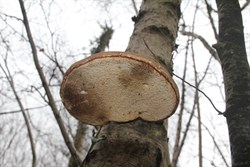Why do trees need fungi?

There are around 1 million fungi species in the world, and it estimated that there are more fungi species than plants on Earth. These species can vary in shape, size and colour, and therefore can be hard to identify as most people are only aware of large fungi that produce visible fruiting bodies such as mushrooms.
Fungi characteristics
Most fungi are microscopic and can only be seen with the naked eye if their microscopic threads (hyphae) form thick growths or moulds. The most familiar species of fungi are those that produce spore-bearing fruiting bodies. These larger or macro-fungi are puff balls, coral fungi, earthstars, truffles and other forms of mushrooms or toadstools.
Fungi can be a source of food and habitat for organisms. Some invertebrates may breed within toadstools and feed off the fungi on dead leaves and wood. Some species of fungi can be detrimental to tree health and cause fungal decay, which may cause the tree to become brittle and unstable.
There are fungi that are geographically and biologically restricted and have become rare or even endangered. Other fungi species have declined due to pollutants and the loss of habitat due to deforestation and the cultivation of land. Therefore, woodland management should incorporate fungi conversation to allow woodland ecosystems to contain a level of rotting branches, fallen dead wood and leaf litter.
Decomposers
The nutrient cycle in woodlands is extremely important for an organism’s survival and can be aided by fungi. As decomposers, fungi transport, store, release and recycle phosphorous and nitrogen, allowing a continuous supply of them within the ecosystem.
Decomposer fungi are vital. They decompose inorganic matter such as rotting branches, fallen dead wood and leaf litter from trees to release nutrients back into the soil to increase fertility. These nutrients are then taken up by the roots of plants, trees and organisms within that ecosystem. This process of decomposing within a woodland ecosystem can be done by fungi, as well as bacteria, worms, woodlice and other invertebrates.
Symbiotic relationships
Fungal organisms can form symbiotic relationships with algae to produce lichens that can be found on the bark of trees. Microscopic fungi live inside of a tree and collect moisture from the surrounding environment that the algae need to survive. The algae then use photosynthesis to produce nutrient which the fungi need to survive. These transactions create a symbiotic relationship, as the fungi and algae both produce and digest the nutrients needed for survival.
Fungi can also form symbiotic associations with plant roots. The interaction between fungi and plant roots can protect trees from diseases and transfer nutrients between trees with an excess of nutrients, to those with a shortage.
Ancient & Veteran trees and Natural Woodland
Within a woodland, the most valuable habitat for fungi is an ancient tree and the fungal species found may be of great age, similar to the age of the ancient tree. This could mean that there are fungal species that have colonised the tree in previous centuries and therefore may have been preserved along with the tree, making the fungal species a potential rare find. Veteran trees may also be a source of high fungal biodiversity as there may be a wide range of species within one piece of fallen wood.
Fungi can cause heart rot within a tree which is beneficial within an ancient tree. Heart rot makes a tree more flexible and lighter, preventing the tree from becoming too heavy and falling over during light winds and lightning strikes. However, the lack of weight is compensated by new growth around the cavity which tends to be stronger than average wood, and the tree rings that develop after the heart rot are thicker than normal.
Fungi can maintain tree diversity in natural woodlands and provide an explanation as to why recent secondary woodlands are different from ancient woodlands. The species of trees in a natural woodland are dependent on the additional nitrogen and phosphorous created by fungal activity within the soil.
More information on veteran trees in our Ancient & Veteran Trees section.
Additional information on fungi can be found in RFS QJF 2013.





